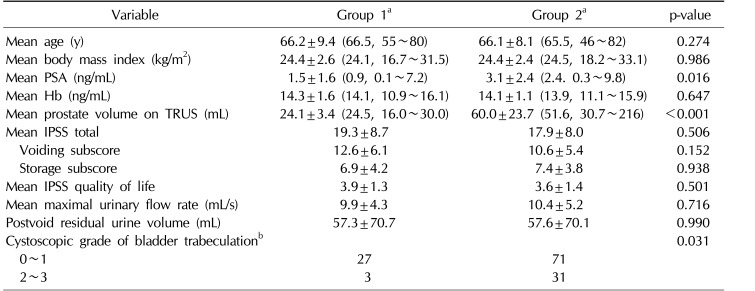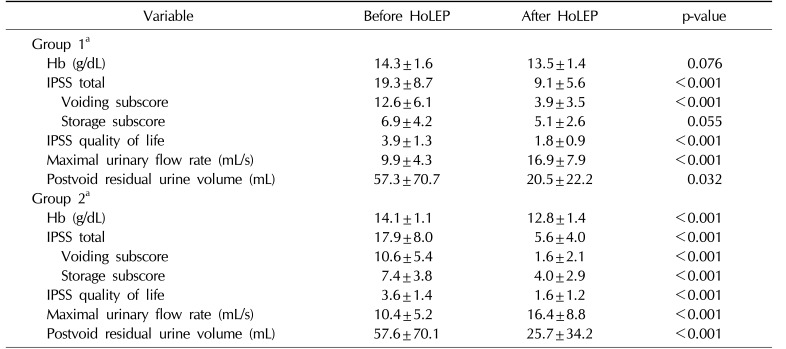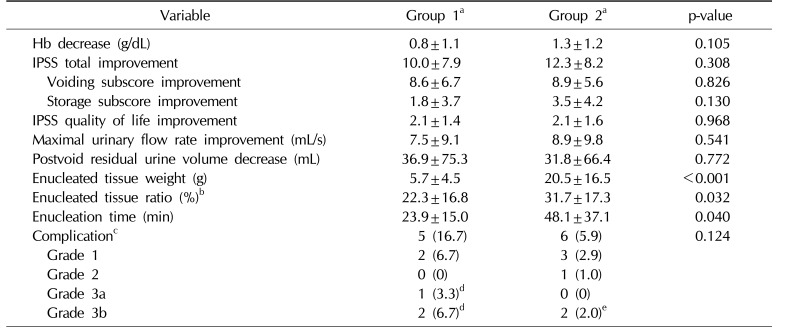1. McConnell JD, Roehrborn CG, Bautista OM, Andriole GL Jr, Dixon CM, Kusek JW, et al. The long-term effect of doxazosin, finasteride, and combination therapy on the clinical progression of benign prostatic hyperplasia. N Engl J Med. 2003; 349:2387–2398. PMID:
14681504.

2. Ruszat R, Wyler S, Forster T, Reich O, Stief CG, Gasser TC, et al. Safety and effectiveness of photoselective vaporization of the prostate (PVP) in patients on ongoing oral anticoagulation. Eur Urol. 2007; 51:1031–1038. discussion 1038-41. PMID:
16945475.

3. Giannarini G. Editorial comment on: Holmium laser enucleation versus transurethral resection of the prostate: 3-year follow-up results of a randomized clinical trial. Eur Urol. 2007; 52:1463. PMID:
17499426.

4. Malaeb BS, Yu X, McBean AM, Elliott SP. National trends in surgical therapy for benign prostatic hyperplasia in the United States (2000-2008). Urology. 2012; 79:1111–1116. PMID:
22546389.

5. McVary KT, Roehrborn CG, Avins AL, Barry MJ, Bruskewitz RC, Donnell RF, et al. Update on AUA guideline on the management of benign prostatic hyperplasia. J Urol. 2011; 185:1793–1803. PMID:
21420124.

6. Gilling PJ, Cass CB, Malcolm AR, Fraundorfer MR. Combination holmium and Nd:YAG laser ablation of the prostate: initial clinical experience. J Endourol. 1995; 9:151–153. PMID:
7633476.

7. Masui K, Yoshimura K, Nishiyama H, Okuno H, Ogawa O. Transition in type of surgery for benign prostatic hyperplasia: a multi-institutional study in Japan. Low Urin Tract Symptoms. 2011; 3:104–108. PMID:
26676395.

8. Kuntz RM, Lehrich K, Ahyai S. Does perioperative outcome of transurethral holmium laser enucleation of the prostate depend on prostate size? J Endourol. 2004; 18:183–188. PMID:
15072628.

9. Mayer EK, Kroeze SG, Chopra S, Bottle A, Patel A. Examining the ‘gold standard’: a comparative critical analysis of three consecutive decades of monopolar transurethral resection of the prostate (TURP) outcomes. BJU Int. 2012; 110:1595–1601. PMID:
22540956.

10. Yin L, Teng J, Huang CJ, Zhang X, Xu D. Holmium laser enucleation of the prostate versus transurethral resection of the prostate: a systematic review and meta-analysis of randomized controlled trials. J Endourol. 2013; 27:604–611. PMID:
23167266.

11. Lee MH, Yang HJ, Kim DS, Lee CH, Jeon YS. Holmium laser enucleation of the prostate is effective in the treatment of symptomatic benign prostatic hyperplasia of any size including a small prostate. Korean J Urol. 2014; 55:737–741. PMID:
25405016.

12. Elshal AM, Elkoushy MA, Elmansy HM, Sampalis J, Elhilali MM. Holmium:YAG transurethral incision versus laser photoselective vaporization for benign prostatic hyperplasia in a small prostate. J Urol. 2014; 191:148–154. PMID:
23845460.

13. Jung JH, Cho SY, Yoo C, Oh SJ. Establishment of the novel cystoscopic classification for bladder trabeculation of neurogenic bladder. Urology. 2014; 84:515–519. PMID:
25168525.

14. Ku JH, Kim SW, Paick JS. Impact of prostate volume on the efficacy of high-power potassium-titanyl-phosphate photoselective vaporization of the prostate: a retrospective, short-term follow-up study on evaluating feasibility and safety. Yonsei Med J. 2010; 51:877–882. PMID:
20879054.

15. Morgan M, Smith N, Thomas K, Murphy DG. Is Clavien the new standard for reporting urological complications? BJU Int. 2009; 104:434–436. PMID:
19338541.

16. Kuntz RM, Lehrich K, Ahyai SA. Holmium laser enucleation of the prostate versus open prostatectomy for prostates greater than 100 grams: 5-year follow-up results of a randomised clinical trial. Eur Urol. 2008; 53:160–166. PMID:
17869409.

17. Logie J, Clifford GM, Farmer RD. Incidence, prevalence and management of lower urinary tract symptoms in men in the UK. BJU Int. 2005; 95:557–562. PMID:
15705080.

18. Izard J, Nickel JC. Impact of medical therapy on transurethral resection of the prostate: two decades of change. BJU Int. 2011; 108:89–93. PMID:
20883490.

19. Thomas AW, Cannon A, Bartlett E, Ellis-Jones J, Abrams P. The natural history of lower urinary tract dysfunction in men: minimum 10-year urodynamic followup of transurethral resection of prostate for bladder outlet obstruction. J Urol. 2005; 174:1887–1891. PMID:
16217330.

20. Khoury AE, Dave S, Peralta-Del Valle MH, Braga LH, Lorenzo AJ, Bägli D. Severe bladder trabeculation obviates the need for bladder outlet procedures during augmentation cystoplasty in incontinent patients with neurogenic bladder. BJU Int. 2008; 101:223–226. PMID:
17970790.

21. Holm NR, Horn T, Smedts F, Nordling J, de la Rossette J. The detrusor muscle cell in bladder outlet obstruction: ultrastructural and morphometric findings. Scand J Urol Nephrol. 2003; 37:309–315. PMID:
12944189.
22. Kang YJ, Kim KH, Seo Y, Lee KS. Effect of transurethral resection of the prostate on storage symptoms in patients with benign prostatic hyperplasia of less than 30 ml. World J Mens Health. 2013; 31:64–69. PMID:
23658868.

23. Saito K, Hisasue S, Ide H, Aoki H, Muto S, Yamaguchi R, et al. The impact of increased bladder blood flow on storage symptoms after holmium laser enucleation of the prostate. PLoS One. 2015; 10:e0129111. PMID:
26090819.

24. Ficarra V, Cavalleri S. Editorial comment on: holmium laser enucleation versus transurethral resection of the prostate: 3-year follow-up results of a randomized clinical trial. Eur Urol. 2007; 52:1464. PMID:
17499428.

25. Reich O, Gratzke C, Bachmann A, Seitz M, Schlenker B, Hermanek P, et al. Morbidity, mortality and early outcome of transurethral resection of the prostate: a prospective multicenter evaluation of 10,654 patients. J Urol. 2008; 180:246–249. PMID:
18499179.

26. Ahyai SA, Lehrich K, Kuntz RM. Holmium laser enucleation versus transurethral resection of the prostate: 3-year follow-up results of a randomized clinical trial. Eur Urol. 2007; 52:1456–1463. PMID:
17499427.

27. Krambeck AE, Handa SE, Lingeman JE. Experience with more than 1,000 holmium laser prostate enucleations for benign prostatic hyperplasia. J Urol. 2010; 183:1105–1109. PMID:
20092844.

28. Kim M, Piao S, Lee HE, Kim SH, Oh SJ. Efficacy and safety of holmium laser enucleation of the prostate for extremely large prostatic adenoma in patients with benign prostatic hyperplasia. Korean J Urol. 2015; 56:218–226. PMID:
25763126.

29. Haraguchi T, Takenaka A, Yamazaki T, Nakano Y, Miyake H, Tanaka K, et al. The relationship between the reproducibility of holmium laser enucleation of the prostate and prostate size over the learning curve. Prostate Cancer Prostatic Dis. 2009; 12:281–284. PMID:
19581921.

30. Nam JK, Kim HW, Lee DH, Han JY, Lee JZ, Park SW. Risk factors for transient urinary incontinence after holmium laser enucleation of the prostate. World J Mens Health. 2015; 33:88–94. PMID:
26331125.








 PDF
PDF ePub
ePub Citation
Citation Print
Print



 XML Download
XML Download